13.3
Impact Factor
Theranostics 2011; 1:102-126. doi:10.7150/thno/v01p0102 This volume Cite
Review
Integrin Targeting for Tumor Optical Imaging
National Institute of Biomedical Imaging and Bioengineering (NIBIB), National Institute of Health (NIH), Bethesda, MD
Published 2011-2-1
Abstract
Optical imaging has emerged as a powerful modality for studying molecular recognitions and molecular imaging in a noninvasive, sensitive, and real-time way. Some advantages of optical imaging include cost-effectiveness, convenience, and non-ionization safety as well as complementation with other imaging modalities such as positron emission tomography (PET), single-photon emission computed tomography (SPECT), and magnetic resonance imaging (MRI). Over the past decade, considerable advances have been made in tumor optical imaging by targeting integrin receptors in preclinical studies. This review has emphasized the construction and evaluation of diverse integrin targeting agents for optical imaging of tumors in mouse models. They mainly include some near-infrared fluorescent dye-RGD peptide conjugates, their multivalent analogs, and nanoparticle conjugates for targeting integrin αvβ3. Some compounds targeting other integrin subtypes such as α4β1 and α3 for tumor optical imaging have also been included. Both in vitro and in vivo studies have revealed some promising integrin-targeting optical agents which have further enhanced our understanding of integrin expression and targeting in cancer biology as well as related anticancer drug discovery. Especially, some integrin-targeted multifunctional optical agents including nanoparticle-based optical agents can multiplex optical imaging with other imaging modalities and targeted therapy, serving as an attractive type of theranostics for simultaneous imaging and targeted therapy. Continued efforts to discover and develop novel, innovative integrin-based optical agents with improved targeting specificity and imaging sensitivity hold great promises for improving cancer early detection, diagnosis, and targeted therapy in clinic.
Keywords: optical imaging, near-infrared fluorescence, multivalent RGD peptides, multifunctional probes, nanoparticle-based optical agents.
1. Introduction
Optical imaging for cancer research Cancers continue to threaten human health and life even with the availabilities of chemotherapy, radiotherapy, and surgery as well as various methods for detection and diagnosis. The challenges with cancer early detection, diagnosis, effective therapy, and even prevention have spurred the discovery and development of new technologies and approaches for cancer research and drug discovery. The past decade has witnessed the burgeoning of optical imaging and its wide applications in biomedicines such as genomics, proteomics, cell biology, and drug discovery. Optical imaging has emerged as a real-time, sensitive, and noninvasive modality for visualization, localization, and measurement of bioactive molecules, molecular recognitions, and molecular processes in vivo. Even though optical imaging still cannot compete with PET, MRI, and CT in clinical applications now, the advantages of optical imaging in convenient use, sensitivity, cost effectiveness, and non-ionization safety have especially made it a spearhead among the traditional imaging modalities for molecular imaging in preclinical studies. Optical imaging of receptors, enzymes, gene expression, live cells, and tumors in vitro and in vivo has deepened our understanding of disease progression and therapeutic response at the molecular, cell, tissue, and whole-animal levels. Therefore, optical imaging holds great promise for cancer early detection, diagnosis, prevention and therapy as introduced in many excellent review articles [1-14].
Optical imaging methods for in vivo tumor imaging Over the past years, different kinds of optical imaging techniques have been developed for biomedical applications. They include various microscopy methods such as confocal microscopy, two-photon microscopy, and coherent anti-Stokes Raman scattering (CARS) microscopy for in vitro and ex vivo applications as well as several methods for in vivo applications such as bioluminescence imaging, fluorescence imaging, diffused optical tomography, and optical coherence tomography. Various techniques can be used in combination, either simultaneously or sequentially, to provide complementary information from the same cells, tissues, organs, or animals [10]. Among them, both fluorescence and bioluminescence imaging techniques have found wide applications for in vivo tumor optical imaging in mouse models and afford convenient, frequent visualization and measurement of tumor biomarkers in a real time, sensitive, and noninvasive way. It also can allow for longitudinal detection of disease progression and therapeutic response in the same animals so as to minimize the subject-to-subject variability and reduce the animal number required by a traditional method. Importantly, such in vivo studies are very valuable for bridging the gap between in vitro (cell/tissue level) and in vivo (the whole animal) studies and facilitating preclinical and further translational studies.
Bioluminescence imaging (BLI) is typically based on the ATP- and O2-dependent enzymatic conversion of exogenous luciferin to oxyluciferin by luciferase within living cells. The reaction can produce photons with a broad red and far-red emission spectrum of a peak around 560 nm which can be detected by a highly sensitive charge-coupled device (CCD) camera at 10-12 min after intraperitoneal injection of luciferin. The bioluminescence can last over 60 min in mice, allowing for the recording of multiple images of disease progression and therapeutic response based on the changes in the number of cells with luciferase expression or transcriptional activity. BLI has allowed quantitative measurements of tumor burden, treatment response, immune cell trafficking, and detection of gene transfer. Spatiotemporal information can be rapidly obtained in the context of whole biological systems in vivo, which can accelerate the development of experimental therapeutic strategies [13, 15].
Fluorescence imaging is to excite certain fluorophores in a living system by using external light and detect fluorescence emission with a sensitive CCD camera. The fluorophores can be endogenous molecules (such as collagen or hemoglobin), exogenous fluorescent molecules such as green fluorescent protein (GFP) or small synthetic optical contrast agents. Compared to in vitro fluorescence microscope, in vivo fluorescence imaging is a complex process affected by many factors. One great limitation of in vivo fluorescence imaging is from light attenuation and scattering by adjacent living tissues. Light in the near infrared (NIR) window (650-900 nm) instead of visible light can improve the light penetration [13, 16]. It can also minimize the autofluorescence of some endogenous absorbers such as hemoglobin, water, and lipids. In a whole mouse illumination experiment, photon counts in the NIR range (670 nm) are about 4 orders of magnitude higher compared to those in the green light range (530 nm) under similar conditions. Near-infrared fluorescence imaging has provided an effective solution for improving the imaging depth along with sensitivity and specificity. Therefore, fluorophores emitted at the NIR region are important for successful in vivo optical imaging and future clinical applications.
NIR fluorophores and targeted delivery Different kinds of fluorescent fluorophores have been discovered for biomedical imaging [1, 7, 16]. They include: 1) small synthetic fluorophores such as cyanine fluorophores (including benzoxazole, benzothaizole, indolyl, 2-quinoline or 4-quinoline cyanine analogs), tetrapyrrol chromophores (such as porphyrins, chlorins, benzochlorins, bacteriochlorin and phthalocyanines), rare earth metal chelates (such as terbium and europium complexes), and xanthenes dyes (such as fluorescein- and rhodamine-type fluorophores); 2) synthetic fluorescent nanoparticles such as semiconductor nanocrystals, i.e. quantum dots (QDs) [17] and fluorescent viral nanoparticles [18]; and 3) fluorescent biological nanoparticles such as GFP and many other fluorescent proteins [19-20]. Among them, the NIR fluorescent fluorophores most commonly used for in vivo imaging are some synthetic cyanine analogs such as commercially available Cy5, Cy5.5, Cy7, Cy7.5, and their analogs of different conjugation groups and linkers (Fig. 1). They have medium to high extinction coefficients with emission spectra in the NIR range. They can be synthesized in a straightforward manner and modified to have different physicochemical properties such as hydrophilicity, absorption, and emission wavelength for different applications. They have suitable photo- and chemical stability desirable for chemical modification as well as in vitro and in vivo applications. Their characteristic NIR fluorescent properties can usually be retained after conjugation with proteins, peptides, and other bioactive materials for in vivo imaging. Noteworthy, a known carbocyanine analog indocyanine green (ICG) has been used as nonspecific blood flow tracer in human studies for cancer detection. It is the first dye used in optical imaging of tumors both in animal studies and for patients [7, 21-25]. Therefore, its well-established bio-safety profile may facilitate the translational studies and clinic applications of such a type of cyanine-labeled compounds. In addition to cyanine fluorophores, QDs represent an attractive class of fluorescent nanoparticle probes for in vivo fluorescence imaging. They usually have a core/shell structure of 2-8 nm in diameter with size-dependent fluorescence emission. Their unique optical properties include high absorbance, high quantum yield, narrow emission bands, large Stokes shifts, and high photobleaching resistance. QDs can be excited with a single wavelength to give emissions at several different wavelengths for multiplex detection of multiple targets in a single experiment [17, 26].
Chemical structures of some representative cyanine fluorophores.

It is ideal to have an imaging agent selectively homed in the tumor lesions for best imaging contrast and diagnostic accuracy in vivo. Nevertheless, most of the dyes themselves are not tumor-specific. Especially, the in vivo performance of an imaging probe can be complicated by its interactions with many bio-molecules, membranes and related cellular permeability or tissue penetration as well as pharmacokinetic process including absorption, distribution, metabolism, and excretion (ADME). Therefore, it has been challenging to discover and develop an optimal optical imaging agent for in vivo tumor optical imaging. As demonstrated by many successful examples, some tumor-specific molecular markers and related molecular recognitions, i.e. ligand-receptor, enzyme-substrate, and antibody-antigen interactions may provide effective approaches for targeted delivery of therapeutic agents and imaging agents such as immunotoxins and radioimmunotherapeutics for cancer imaging and therapy. Especially, some cell surface receptors over-expressed by cancer cells and/or neovascular endothelial cells can serve as specific molecular markers for tumor targeting and molecular imaging [27-30]. Conjugations of some receptor ligands (such as peptides, aptamers, and antibodies) endow an optical probe with receptor-targeting and tumor-homing ability to enhance the optical signals from tumors and improve sensitivity and specificity of in vivo tumor optical imaging. Such receptor-targeted optical imaging agents can also be used to probe the receptor expressions, signal pathways, functions and modulations, providing some meaningful information for cancer diagnosis, early detection, staging, and therapeutic response as well as anticancer drug discovery.
2. Integrin-Targeting Optical Agents for Tumor Imaging
The integrins are a family of heterodimeric cell surface receptors (24 subtypes) composed of two non-covalently bound α- and β- subunits. They are expressed on a wide variety of cells to mediate cell-extracellular matrix and cell-cell interactions by transducing signals into the cells and out of the cells for regulating different cellular functions such as cell survival, proliferation, adhesion, migration, and invasion as well as angiogenesis, thrombosis, apoptosis, and differentiation in various pathological processes. Integrin receptors also involve complex cross-talk with other signaling cascades like angiogenic growth factor VEGF [31], nonreceptor tyrosine kinase Src [32], and chemokine receptor CXCR4 in tumor biology [33]. As reported by Lorger et al. [34], activation of tumor cell integrin αvβ3 controls angiogenesis and metastatic growth in the brain and could serve as a valuable target for the inhibition of brain metastasis. Several potent small-molecule αvβ3 antagonist-based RGD compounds have been studied under clinical trials for anti-angiogenesis, drug delivery, and cancer imaging [34]. The promising results have highly suggested that integrin receptors are important targets for molecular imaging, drug delivery and therapy. The complex structures and important functions of integrins in oncology as well as the ineffectiveness of some antagonists in clinic have spurred further research via optical imaging and related discovery of novel integrin-targeting ligands.
Noteworthy, immense researches have been performed by other noninvasive imaging methods including PET, SPECT, and MRI to demonstrate the integrin-targeting for cancer imaging as described previously. Among many integrin-targeting molecular imaging agents, a glycosylated cyclo(RGDfK) derivative i.e. [18F]galacto-RGD was the first applied in patients and has been successfully assessed in more than 100 patients so far [35-37]. The related concept of receptor targeting, animal models, and experimental results all have facilitated discovery and development of the integrin-tageting optical imaging agents. Over the past years, there are many reports on integrin-targeting for in vivo tumor optical imaging. It has also been demonstrated that integrin antagonists provide an effective way for targeted delivery of NIR fluorophores for tumor targeting and optical imaging. As summarized below, different kinds of integrin-targeted NIR optical probes for in vivo optical imaging have been constructed and evaluated in vitro and in vivo. They represent some of the most creative work by successful convergence of molecular design, synthetic chemistry, optical imaging, nuclear imaging, molecular targeting, cancer biology, and nanotechnology. Many advances in NIR fluorophores have made it feasible to discover and develop new generations of integrin-targeted optical imaging agents to not only improve sensitivity and specificity of tumor imaging but also provide complementary imaging information for cancer diagnosis, detection, and prognosis. Finally, the promising integrin-targeted optical imaging probes may serve as a new type of targeted optical oncologic drugs for both cancer imaging and therapy.
Construction of integrin-targeted optical probes: General considerations One underlying theme in in vivo optical imaging is to discover and develop novel innovative receptor-targeted optical probes for cancer optical imaging. Such receptor-targeted optical probes also have potentials for both imaging and therapy. Generally, a receptor-targeted imaging agent can be obtained by labeling a receptor ligand with an imaging agent.
For an optical imaging agent, it usually contains three components i.e. ligand, fluorophore, and linker as showed in Figure 2. Conjugation chemistry used is related to the functionalities of the ligand, fluorophore, and the resulting conjugate structures. Different fluorophores containing amino, carboxylic acid, and its active N-hydroxysuccinimide (NHS) ester groups can be frequentlyused in the ligand conjugation. More specific reactions based on mercapto-mercapto, maleimide-mercapto, and azido-alkyne reactions have also been used to conjugate with some un-protected multifunctional ligands for the synthesis of complex conjugates.
Schematic representation of general receptor-targeted optical agents.
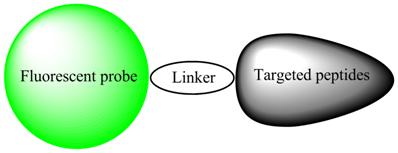
It is important to consider some factors in the construction of integrin-targeting optical agents as follows:
- Ligand and receptor interaction: Just like other receptor-targeted imaging agents, it is important to choose an appropriate receptor-targeted ligand, fluorophore, and linker for construction of novel integrin-targeted optical agents with optimal receptor targeting activity. An ideal ligand should have specific high receptor binding affinity and selectivity with a receptor of abundant, unique expression on tumor cells, but negligible or low expression on normal cells. The receptor binding affinity should be retained or not be dramatically changed after conjugation with fluorophore. Importantly, the receptor binding affinity of a ligand can be enhanced by some different approaches such as dimerization and multimerization [38-40].
- Fluorophore: Various types of fluorophores have been discovered for optical imaging as described above. Cyanine dyes such as Cy5.5 have been widely used for labeling ligands for optical imaging [1, 7, 12]. The physicochemical properties especially optical properties such as absorbance wavelength, emission wavelength, extinction coefficient, fluorescence quantum yield, and life time are crucial for successful optical imaging. The molecules of many fluorophores such as cyanine dyes contain a strong conjugated system consisting of some aromatic rings. It is essential to consider the impacts of fluorophores on the receptor binding, biological activities and in vivo performance. It is significant to exploit the synergistic effect of a fluorophore motif on the ligand-receptor interactions as reported by Achilefu et al. [41]. Especially, their molecular size, steric hindrance, and hydrophobicity may become detrimental for the biological activities of some small molecules.
- Linker: As an essential part connecting a fluorophore and a ligand, a linker including its structural type, length, hydrophilicity, and rigidity can frequently have important effects on the receptor targeting of a conjugate. It is reported that polyethylene glycol linker and simple oligopeptide sequence such as Gly-Gly-Gly used in the conjugation of a dimeric RGDfK with DOTA showed significant effects on distribution, pharmacokinetics, and tumor imaging [42].
- Molecular diversity: An optical agent can be further modified structurally to improve receptor targeting specificity, minimize nonspecific binding and achieve high tumor imaging sensitivity and specificity. Molecular diversity is an important approach for molecular design to delineate the structure-activity relationship and discover novel optimal compounds. As described above, the structure of an integrin-targeted optical agent provides at least three points for molecular diversity. Different kinds of fluorophores including small molecules and nanoparticles can be used in the construction of novel integrin-targeted optical imaging agents. Fluorophores such as cypate can be used as an optical scaffold for constructing novel optical agents such as some cyclic, divalent, and multivalent analogs [40,43] to further increase the molecular diversity. Significantly, some fluorescent nanoparticles allow incorporations of multiple functionalities for simultaneous tumor-targeting, imaging, and therapy, serving as potential tumor-targeted theranostic nanoparticles.
Evaluation of integrin-targeted optical probes Generally speaking, the integrin-targeted optical agents can be evaluated in several aspects:
- Physico-chemical properties: These include optical properties such as absorption, emission, extinction coefficient, life time, fluorescence quantum yield, and photo-stability. It is also important to determine the solubility of a compound as higher lipophilicity may lead to more nonspecific tissue absorption [7, 16, 44].
- In vitro studies: These include receptor binding, cell staining, cellular internalization, subcellular localization, and cytotoxicity. Fluorescence, confocal, and intravital microscopes are usually used in their assays. It is important to establish the receptor targeting specificity by several different ways: 1) the compound can bind and be internalized by receptor-positive cell lines, 2) the cell binding and internalization of the compounds can be blocked with excessive amount of a free ligand either pre- or co-incubated with the cells, and 3) no measureable cellular binding and internalization occurs with either receptor-negative cell lines or cells from which the receptor has been cleaved [28, 45].
- In vivo studies: The compounds can be studied for their tumor uptake, bio-distribution, and related kinetics using noninvasive optical imaging system. In vivo specificity can similarly be evaluated by: 1) comparing uptake of the compound in a known receptor-positive tumor with its uptake in several receptor-negative tissues; 2) examining the competitive blockade of the compound's localization in tumor upon pre-or co-injection of the animal with excessive amount of a free ligand [28, 45].
The primary goal of integrin-targeting optical agents is for targeted delivery of optical imaging agents to improve the image contrast and accuracy. Nonspecific binding is usually hard to avoid, leading to obscure imaging results in vivo. The in vivo performance of an optical agent might also be devalued by its decomposition, metabolism, distribution, and excretion in the complex in vivo environments. Frequently, the in vitro and in vivo results may be ambiguous and contradictable, which have highlighted the continuing efforts to the discovery of some new optimal optical agents for tumor optical imaging. Some more complex activatable optical imaging agents have been reported. New integrin-targeted optical imaging agents have also been adapted for multimodal imaging and new optical imaging methods. All these have represented the new generation of targeted optical agents.
3. NIR Fluorescent RGD Peptides
Among the known 24 integrin subtypes, integrin αvβ3 has been widely investigated for tumor imaging and therapy due to its important roles in angiogenesis, growth, and metastasis of some tumors. Especially, integrin αvβ3 has been an attractive marker for diagnostic imaging of tumor angiogenesis due to its high expression on activated and proliferating endothelial cells during tumor angiogenesis and metastasis in contrast to resting endothelial cells and most normal organs. Integrin αvβ3 binds some extracellular matrix proteins such as vitronectin via Arg-Gly-Asp (RGD) sequence, so diverse RGD peptide ligands have been developed to target integrin αvβ3 and angiogenic vessels. Among them, a class of cyclic RGD penta-peptide analogs including c(RGDfV) and c(RGDfK) is outstanding for its high receptor binding affinity and specificity. Various types of imaging probes for diagnostic imaging have been discovered based on such a type of cyclic RGD peptide template. For example, 18F-galacto-RGD i.e. 18F-labeling RGD-containing glycopeptide has been studied with melanoma, sarcoma, and breast cancer patients in clinical trials [36-37]. Therefore, many integrin αvβ3-targeted optical imaging agents have been built on the cyclic RGD template similarly.
Two Cy5.5-labeled cyclic RGD analogs i.e. Cy5.5-(RGDfK) and Cy5.5-(RGDyK) (Fig. 3) were first reported for in vivo optical imaging of integrin αvβ3 positive tumors in mouse models and showed high contrast images [46-47]. Gurfinkel et al. reported dynamic fluorescence imaging of a subcutaneous human Kaposi's sarcoma tumor (KS1767) model by the intravenous injection of Cy5.5-c(RGDfK). The dye conjugate had specific tumor uptake which can be blocked by c(RGDfK) [48]. As reported by Chen et al. [46], 1.5 nmol monomeric Cy5.5-RGD was injected via the tail vein in an orthotopic brain tumor model and detected by a three-dimensional optical imaging system (IVIS 200) 0-24 hours. The highest tumor uptake and tumor to normal brain tissue ratio were observed two hours post-injection (2.64±0.20). The tumor uptake of Cy5.5-RGD was effectively blocked by c(RGDyK). Fluorescence microscopy further demonstrated specific Cy5.5-RGD binding to both U87MG tumor vessels and tumor cells without normal tissue binding compared with the nonspecific binding of Cy5.5.
The structures of both Cy5.5-c(RGDfK) (X: H) and Cy5.5-c(RGDyK) (X: OH).

NIR fluorescent Cy5.5-E{E[c(RGDyK)]2}2 Strong and specific receptor binding of a probe to the cell surface receptor is important for successful receptor targeting and tumor imaging. The monomeric RGD analog showed promising results both in vitro and in vivo but its moderate integrin binding affinity may weaken tumor uptake and related in vivo performance. Dimerization or multimerization of the cyclic RGD peptide provided a viable approach to improve the binding affinity and in vivo imaging [35, 42, 45]. For example, various dimeric and tetrameric RGD analogues including E-[c(RGDfK)]2, E-[G-G-G-c(RGDfK)]2, and E-{G-[c(RGDfK)]2}2, were prepared and labeled with various radionuclides such as 18F, 64Cu, 68Ga, and 99mTc. All the peptides had stronger binding than the monomeric counterpart in integrin αvβ3-positive U87MG xenograft models. The improvements might be ascribed to the increased “local concentration” of the RGD peptide in the vicinity of receptors for synergistic interactions with the receptors. These peptide probes may serve as valuable tools for nuclear imaging of tumor angiogenesis with great potentials in the clinic. One 18F-labeled RGD dimer, i.e. 18F-FPPRGD2, has been approved for exploratory investigative new drug application by FDA. All these results spurred further studies on these multivalent RGD and their interactions with integrin αvβ3 by optical imaging in the tumor-bearing mouse models.
Cheng et al. [45] evaluate three novel NIRF probes i.e. monomeric Cy5.5-c(RGDyK), dimeric Cy5.5-E[c(RGDyK)]2, and tetrameric Cy5.5-E{E[c(RGDyK)]2}2 (Fig. 4) in a subcutaneous U87MG glioblastoma xenograft model. The binding affinities of Cy5.5-conjugated RGD monomer, dimer, and tetramer for integrin αvβ3 expressed on U87MG cell surface were 42.9±1.2, 27.5±1.2, and 12.1±1.3 nM, respectively. The subcutaneous U87MG tumor was clearly visualized with the three fluorescent probes. All the three compounds had integrin specific uptake both in vitro and in vivo. The tetramer displayed highest tumor uptake and tumor-to-normal tissue ratio from 0.5 to 4 h post-injection. Tumor-to-normal tissue ratios at 4 h postinjection were found to be 3.18 ± 0.16 (monomer), 2.98 ± 0.05 (dimer), and 3.63 ± 0.09 (tetramer), respectively. The tetramerization of RGD peptide resulted in moderate improvement of imaging characteristics, compared to that of the monomer and dimeric counterparts. These results suggest that Cy5.5-labeled monomeric, dimeric, and tetrameric RGD peptides all have potential for imaging of integrin expression. Such probes should be also valuable for further studying the related integrin αvβ3-mediated signaling transductions.
The structures of three Cy5.5- RGD conjugates, i.e. monomer Cy5.5-c(RGDyK), dimer Cy5.5-E[c(RGDyK)]2, and tetramer Cy5.5-E{E[c(RGDyK)]2}2.
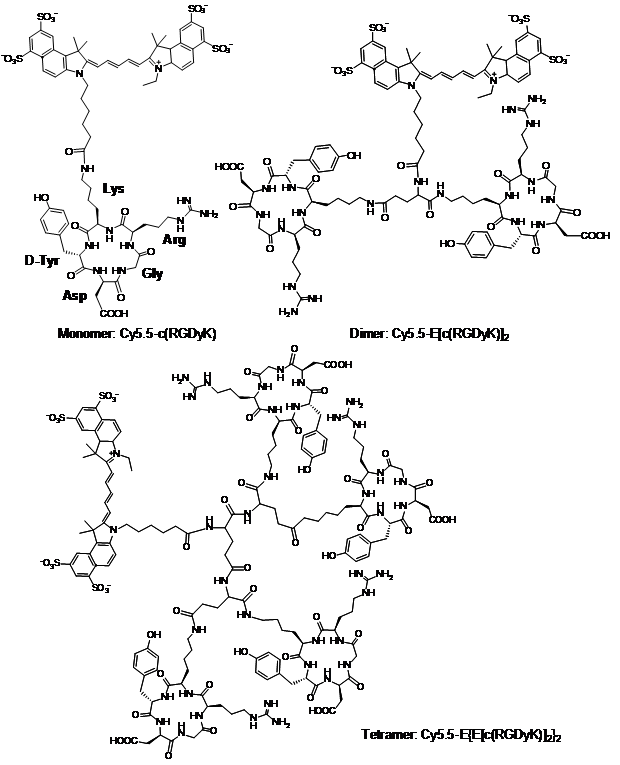
IRDye800-E[PEG4-c(RGDfK)]2 Recently, Liu et al. further studied optical imaging of tumor integrin αvβ3 expression by using a near-infrared fluorescent IRDye®800CW-labeled cyclic RGD dimer with a tetra(ethylene glycol) (PEG4) linker i.e., E[PEG4-c(RGDfK)]2, PEG4=15-amino-4,7,10,13 tetraoxapentadecanoic acid) in a U87MG tumor model. In vivo NIRF imaging showed higher tumor accumulation and tumor to background contrast of IRDye800-E[PEG4-c(RGDfK)]2 over IRDye800-E[c(RGDfK)]2 without the PEG4 linker. The tumor integrin αvβ3 specificity of IRDye800-E[PEG4-c(RGDfK)]2 was confirmed by inhibition of tumor uptake using an excess dose of c(RGDfK) [42].
Cy5-labeled RAFT-c(-RGDfK-)4 A new NIR fluorescent Cy5-labeled tetrameric RGD peptide conjugate based on a cyclic decapeptide as regioselectively addressable, functionalized template (RAFT) was reported [49,50]. Four copies of the c(RGDfK) peptide were linked to the upper face of the RAFT platform while Cy5 was attached to its bottom face to give Cy5-RAFT-c(RGDfK)4 (Fig. 5) for optical imaging. This tetramer differs from the previous tetramer by the topological separation of two independent functional domains i.e. integrin αvβ3 targeting domain and optical imaging domain. Cy5-RAFT-c(RGDfK)4 efficiently accumulated into tumors in nude mice. This compound was also evaluated for its potential in noninvasive detection of deep ovarian metastases on subcutaneous tumors and intraperitoneal human ovarian adenocarcinoma IGROV1 cells with low levels of integrin αvβ3 expressing metastases in nude mice. Noninvasive optical imaging showed that the compound exhibited stronger staining in vitro, enhanced tumor-to-background ratio for subcutaneous tumors, and allowed early detection of 1- to 5-mm large intra-abdominal nodules. Histological study revealed that the compound accumulated into tumor neovasculature but also into tumor cells. The results demonstrate that Cy5-RAFT-c(RGDfK)4 is an efficient optical probe for early, noninvasive tumor detection. This compound was also tested with the human embryonic kidney cells HEK293(β3) (high levels of integrin αvβ3) or HEK293(β1) (integrin αvβ3-negative but expressing αV and β1) engrafted subcutaneously in mice. Compared to its monomeric cyclic RGD analogue, Cy5-RAFT-c(RGDfK)4 had higher uptake and longer retention with markedly enhanced contrast in HEK293(β3) than in the HEK293(β1) tumors. Intravenous injection of Cy5-RAFT-c(RGDfK)4 in this pair of HEK293(β3) and HEK293(β1) tumors provided a tumor/skin ratio above 15. Blocking studies further demonstrated the targeting specificity of the compound.
Schematic structure of Cy5-RAFT-c(RGDfK)4.

Integrin αvβ3 targeted dual-modality imaging agents The challenges of cancer diagnosis, detection, and even therapy have highlighted the combination of different imaging modalities in clinic to harness the different features of each modality. As described above, the strength and weakness of optical imaging include cost effectiveness, facile use, safe application, high sensitivity, low tissue penetration depth, and limited applications in clinic. There are some fused X-ray/CT-fluorescence imaging systems. Especially, nuclear imaging including both PET and SPECT has found wide applications in biomedicines. There are tremendous advances in multimodality imaging of tumor integrin αvβ3 expression by magnetic resonance imaging (MRI), ultrasound, near-infrared (NIR) fluorescence, single photon emission computed tomography (SPECT), and positron emission tomography (PET) [51-53]. Several groups have been interested in some novel dual labeling molecules for both optical imaging and nuclear imaging. It may provide a way to overcome the shortcomings and limitations of nuclear imaging in spatial resolution and radiation safety. Especially, it would be very significant to discover novel integrin-targeted dual imaging agents for integrating both highly sensitive and complementary nuclear and optical techniques. Such simultaneous dual imaging by the same molecule may reveal more accurate, comprehensive information of the integrin expression and functions at different anatomical, functional and molecular levels in oncology, facilitating their structural modification, evaluation, and mechanism studies for successful translation into clinical applications.
Li et al. reported the synthesis and evaluation of a dual-labeled RGD (Arg-Gly-Asp) peptide conjugate 111In-DTPA-Lys(IRDye800)-c(KRGDf) composed of both the 111In chelator diethylenetriaminepentaacetic acid (DTPA) and the near-infrared (NIR) fluorescent dye IRDye800 (excitation/emission, 765/792 nm) for dual optical and nuclear imaging in human melanoma xenografts [51]. Mice of tumors injected with the dual-labeled probe were imaged by both gamma scintigraphy and NIR fluorescence optical camera. DTPA-Lys(IRDye800)-c(KRGDf), DTPA-Lys-c(KRGDf) and c(KRGDf) inhibited the adhesion of melanoma M21 cells to vitronectin-coated surface with similar biological activity. The dual-labeled imaging probe 111In-DTPA-Lys(IRDye800)-c(KRGDf) (Fig. 6) was found to specifically bind to integrin αvβ3 in melanoma tumor cells. Both 111In-DTPA-Lys(IRDye800)-c(KRGDf) and 111In-DTPA-Lys-c(KRGDf) had significantly higher uptakes in integrin αvβ3-positive M21 melanoma than in integrin αvβ3-negative M21-L melanoma at 4-48 h after their injection. Side-by-side comparison of images obtained using 111In-DTPA-Lys(IRDye800)-c(KRGDf) revealed that both optical imaging and gamma scintigraphy enabled noninvasive detection of the probe bound to integrin αvβ3-positive tumors in living mice. Optical images provide improved resolution and sensitive detection of the superficial lesions while gamma images provide sensitive detection of deeper structures.
The structures of 111In-DTPA-Lys(IRDye800)-c(RGDfK) and DOTA-cypate-cyclo(RGDfK) (LS308).


Edwards et al. reported another integrin αvβ3-targeted dual imaging probe LS308 bearing a cyclic RGDfK peptide, a tetraazamacrocycle 1,4,7,10-tetraazacyclododecane-N,N',N'',N'''-tetraacetic acid (DOTA) and a near-infrared (NIR) fluorescent dye cypate [54]. LS308 had a high affinity for integrin αvβ3 and internalized preferentially via integrin αvβ3-mediated endocytosis in firefly luciferase transfected 4T1cells. It also selectively accumulated in integrin αvβ3-positve tumors in a receptor-specific manner. The tumor was visualized by bioluminescence (fluc reporter gene), NIR fluorescence (cypate), and SPECT (111In).
As described below, some integrin-targeted dual labeling nanoparticles for both optical and PET have been reported. Such a kind of integrin-targeted dual-labeling imaging agents can fully take the advantages of nanotechnology to discover novel multifunctional imaging agents which are valuable for better understanding of the disease and related biological events for improving disease diagnosis and detection.
Integrin-targeted activatable optical probes Activatable optical probes refer to some fluorescently quenched molecules which can undergo enzymatic conversion to become fluorescently active for optical imaging in a certain environment [55-57]. They are usually obtained by attaching one fluorophore with another fluorophore or a quencher via a certain linker which can be cleaved by some enzymes. Many peptide-based activatable probes can serve as important tools for studying the localization, visualization, and determination of the intrinsic enzyme activities such as MMPs and caspases involved in cancer, inflammation, and vascular disease by optical imaging. The strategy has also become attractive for its potential in improving the image contrast with better signal-noise ratio. Tung et al. reported the first MMP-activatable probe based on a poly-lysine polymer conjugated with a MMP substrate Gly-Pro-Leu-Gly-Val-Arg and Cy5.5, allowing for self-quenching of Cy5.5 by fluorescence resonance energy transfer (FRET) [55]. Lee et al. reported a dark-quenched MMP-13 activatable peptide probe, Cy5.5-Gly-Pro-Leu-Gly-Met-Arg-Gly-Leu-Gly-Lys(BHQ-3), for optical imaging of MMP-13 in a rat osteoarthritis model [58]. Tsien et al. reported in vivo visualization of MMP activities by MRI and fluorescence of dendrimeric nanoparticles coated with activatable cell penetrating peptides (ACPPs), labeled with Cy5, gadolinium, or both. Such nanoparticles had 4- to 15-fold higher uptake in tumors than unconjugated ACPPs [59]. There are some reports on integration of the activatable optical probes and integrin targeting into in vivo tumor optical imaging.
Razkin et al. reported several integrin-targeted NIR fluorescent activatable probes for tumor-targeting imaging in live mice [60]. These include RAFT-(cRGD)4 Cy5-S S-Cy5 (1), RAFT-(cRGD)4 Cy5-S S-QSY21 (2), and RAFT-(cRGD)4 QSY21-S S-Cy5 (3) built on a RAFT as mentioned above (Fig. 7). Such molecules have topological separation of two independent functional domains i.e. integrin αvβ3 targeting domain and imaging domain. The imaging domain consists of two Cy-5 dyes or Cy5 and a diarylrhodamine derivative quencher (QSY21) linked with a disulfide bond for fluorescence quenching. The disulfide bonds are cleaved for fluorescence activation after the integrin-mediated cellular internalization of the three probes because disulfide bridges are known to be reduced enzymatically by thioredoxines in the cytosol. That was first demonstrated in vitro by using 2-mercaptoethanol (2-MCE) and the results showed 100 % recovery upon the S-S bond cleavage. Confocal microscopy confirmed the cellular uptake of RAFT-(cRGD)4 Cy5-S S-Cy5 by live HEK293 cells overexpressing integrin αvβ3 after 1.5 h incubation at 37 °C. It showed weaker staining of the cell membrane than the control compound RAFT(cRGD)4 Cy5. The intracellular signal from the quenched probe appeared with a higher contrast, suggesting site-selective fluorescence activation. The co-localization of RAFT-(cRGD)4 Cy5-S S-Cy5 and a lysosome-labeling dye (LysoTracker Green) suggests lysosome as the possible cleavage location for the disulfide bond. No fluorescence increase was observed upon incubation at 37 °C of 1 M of the activatable Cy5-S S-Q, in plasma or whole blood, for at least 120 min, showing its relative stability in blood. The two compounds i.e. 1 and 2 in PBS 10 mM (pH 7.4, with 10 % DMSO, 10 % EtOH) were injected intravenously at 10 nmol Cy5 per mouse into mice of subcutaneous integrin αvβ3-positive human ovarian cancer cell line IGROV1 tumor for whole body fluorescence imaging. The Cy5 fluorescence recovery of the activatable probes was found slow and the image contrast was greatly augmented 5 h post-injection in comparison to the previously described RAFT-(cRGD)4 Cy5 molecule. The unquenched probe RAFT-(cRGD)4 Cy5 accumulated in the tumor a few minutes post-injection, but the presence of unbound circulating molecules in normal tissues greatly reduced the tumor/background ratio (contrast).
The structures of RAFT-(cRGD)4 Cy5-S S-Cy5 (1), RAFT-(cRGD)4 Cy5-S S-QSY21 (2), and RAFT-(cRGD)4 QSY21-S S-Cy5 (3).

Apoptosis is a programmed cell death process aberrantly involved in the pathogenesis of many diseases. Most of the anticancer drugs work by initiating apoptosis; thus, the imaging and detection of the apoptosis progression could guide the evaluation of cancer chemotherapy. Caspases make up a family of cysteine proteases and are crucial mediators of apoptosis. To detect apoptosis-associated caspase activity in vivo, caspase-activatable NIR fluorescent probe based on a fluorophore pair of Alexa Fluor 647 and QSY 21 as well as a cell-permeable peptide motif Lys-Lys-Lys-Arg-Lys-Val, and a caspase peptide substrate Asp-Glu-Val-Asp has been reported for imaging of caspase activity in apoptotic cells in vitro. Lee et al. reported a complex multifunctional molecule LS498 containing 5 components including DOTA, two quenched fluorophores, capase-3 substrate DEVDAP and integrin-targeting RGD to combine the two strategies i.e. caspase-3 activation and integrin-targeting for tumor optical and nuclear imaging (Fig. 8) [52]. The fluorescence was quenched in the native form and was readily cleaved by caspase-3 to become fluorescent. In mice, the initial fluorescence of LS498 was ten-fold less than control. A time-dependent five-fold NIR fluorescence enhancement was observed using radiolabeled 64Cu-LS498 in a controlled and localized in vivo model of caspase-3 activation, but radioactivity remained identical in both caspase-3 positive and negative controls.
The structure of LS498.

Compared with conventional integrin-targeted agents, such integrin-targeted activatable probes represent a higher level of structural sophistication. In addition to small molecules described above, nanoparticles including polymer conjugates and inorganic nanoparticles have also been used for construction of activatable probes. All these have further expanded the scope and applications of integrin-targeted activatable optical probes.
New integrin targeting peptides for optical imaging Strong evidences from nuclear and optical imaging showed the applications of specific integrin αvβ3 and αvβ5 antagonists such as cyclic RGD peptides in targeted delivery of imaging agents for in vivo tumor imaging targeting. Inhibitors of integrin αvβ3 and αvβ5 have entered clinical trials as antiangiogenic agents for cancer treatment but generally have been unsuccessful. Recently, it is reported that nanomolar concentrations of RGD-mimetic integrin αvβ3 and αvβ5 inhibitors can promote VEGF-mediated tumor angiogenesis and tumor growth in mice which may seriously compromise the anticancer activity of RGD-mimetic integrin αvβ3 and αvβ5 inhibitors. That finding might explain the ineffectiveness of such RGD-mimetic integrin αvβ3 and αvβ5 inhibitors for cancer therapy for the majority of human cancers in clinic. It has also rationalized discovery and development of new integrin ligands which are structurally and functionally different from the conventional cyclic RGD-based integrin αvβ3 and αvβ5 antagonists as oncologic drugs. Many new integrin ligands have been reported and show promising results for optical imaging.
Carlson et al. demonstrated the advantages of low-affinity, multivalent interactions for selective tumor cell targeting over traditional, abiotic, high-affinity targeting methods [61]. They used a bifunctional small-molecule ligand composed of two motifs: (1) an RGD peptidomimetic with tight binding to integrin αvβ3 (Kd ≈ 10 nM) and (2) the galactosyl-α(1-3)galactose (α-Gal epitope) recognized by human anti-α-galactosyl antibodies (anti-Gal). The bifunctional conjugate decorates a cell possessing a high level of integrin αvβ3 to generate multivalent displays of α-Gal epitopes at cell surface which is important for recruiting anti-Gal and thereby triggering complement-mediated lysis. These results highlight the advantages of exploiting the type of the multivalent recognition processes used by physiological systems to discriminate between cells. The results have implications for the treatment of cancer and other diseases characterized by the presence of deleterious cells.
Ye et al. synthesized and evaluated a series of multimeric RGD compounds based on the simple RGD unit and a dicarboxylic acid-containing near-infrared (NIR) fluorescent dye (cypate) scaffold for tumor targeted optical imaging [40]. Some novel NIR fluorescent RGD compounds were thus obtained efficiently, including one RGD monomer (cypate-(RGD)2-NH2), two RGD dimers (cypate-(RGD)2-NH2 and cypate-(RGD-NH2)2), one trimer (cypate-(RGD)3-NH2), two tetramers (cypate-(RGD)4-NH2 and cypate-[(RGD)2-NH2]2), one hexamer (cypate-[(RGD)3-NH2]2), and one octamer (cypate-[(RGD)4-NH2]2) (Fig. 9). The binding affinity of the multimeric RGD compounds for integrin αvβ3 showed a remarkable increase relative to the monomer cypate-RGD-NH2. Generally, the divalent linear arrays of the multimeric RGD units bound integrin αvβ3 with slightly higher affinity than their monovalent analogues. These results suggest that the receptor binding affinity was not only dependent on the number of RGD moieties but also on the spatial alignments of the pendant peptides. Internalization of the compounds by integrin αvβ3-positive tumor cells (A549) was monitored by NIR fluorescence microscopy. The data showed that endocytosis of the octameric RGD derivative was significantly higher by comparison to other compounds in this study. In vivo noninvasive optical imaging and biodistribution data showed that the compounds were retained in A549 tumor tissue. Some integrin-targeted ligands with low affinity showed good tumor targeting and imaging in vivo, so should not be ignored.
von Wallbrunn et al. [63] synthesized a disulfide-based cyclic RGD labeled with a cyanine dye (Cy5.5) for optical imaging of integrin αvβ3 expression in tumor xenografts using both two-dimensional planar (FRI) and three-dimensional tomographic optical imaging methods (FMT) (Fig. 10, upper). The peptide-dye conjugate showed a significant binding with integrin αvβ3-positive M21 and HT-1080 cells while it had little to no fluorescence staining with integrin αvβ3-negative MCF-7 cells. Tumor xenografts were clearly visualized by FRI and FMT up to 24 h post injection. FMT allowed quantification of the fluorochrome distribution in deeper tissue sections. The average fluorochrome concentrations at 60 min post-injection of the probe were found at 417.61 ± 105.82 nM Cy5.5 (M21), 353.68 ± 54.02 nM Cy5.5 (HT-1080) and 262.83 ± 155.36 nM Cy5.5 (MCF-7) in the target tissue. Competition with the free RGD peptide resulted in a reduction in the fluorochrome concentration in M21 tumour tissue (294.35 ± 84.27 nM).
Most of the conventional RGD peptides only delivered the cargo to the blood vessels. Ruoslahti group reported a tumor-homing peptide iRGD (CRGDKGPDC) discovered by phage display for tissue-penetrating delivery [64]. Intravenous injection of iRGD conjugates bound to tumor vessels and spread into the extravascular tumor parenchyma to improve the sensitivity of tumor-imaging agents and enhance the activity of an antitumor drug. The tissue-penetrating delivery involves a three-step process: 1) the binding of RGD motif to αv integrins on tumor endothelium; 2) a proteolytic cleavage of the iRGD for binding with neuropilin-1; 3) neuropilin-1 mediated penetration into tissue and cells. Recently, we synthesized a near-infrared fluorescent analog i.e. IRDye800-iRGD conjugate which showed significant tumor localizationin optical imaging of MDA-MB-435 tumor xenograft-bearing nude mice (Fig. 10).
Multimeric RGD peptides based on cypate scaffold.
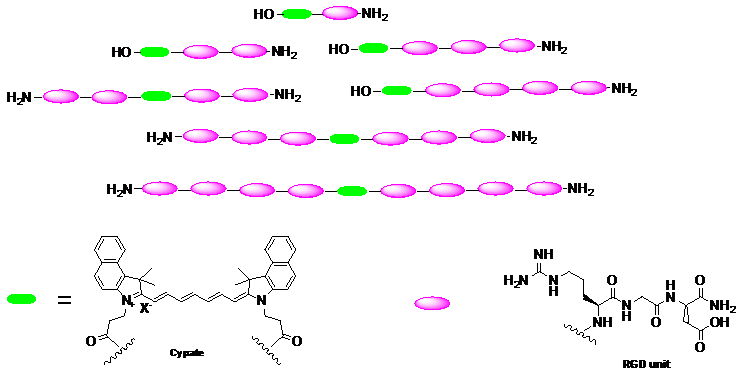
The structures of two disulfide-based cyclic RGD conjugates.


The structure of fluorescently labeled nonpeptidic integrin-targeting compound.

In addition to diverse conventional RGD peptide analogs, many nonpeptidic compounds or peptidomimetics have also received wide attentions for integrin targeting. For example, Heroux et al. reported a synthetic integrin αvβ3-targeted fluorescent probe which had at least 20 times stronger binding affinity for integrin αvβ3than the commercially available cyclic peptide c[RGDfv] (Fig. 11). The compound showed good tumor targeting in vivo as demonstrated by fluorescence imaging. It can identify the site and extent of integrin αvβ3 expression correlated with adventitial thickness in Watanabe Rabbits, serving as a new imaging biomarker for early atherosclerotic disease [65].
Optical imaging of α4β1 integrin Increasing evidences suggest that integrin α4β1 plays a pivotal role in autoimmune diseases and cancer development. Due to the lack of high-affinity targeting ligands, molecular imaging of integrin α4β1 is much less explored than that of integrin αvβ3 and αvβ5 integrins. The Lam group identified a peptidomimetic, LLP2A, that preferentially binds to activated integrin α4β1 using the one bead-one compound combinatorial library method [66]. They further labeled it with Cy5.5 to form LLP2A-Cy5.5 (Fig. 12) for in vivo optical imaging of human lymphoma xenograft. LLP2A-Cy5.5 retained the binding activity and specificity to integrin α4β1 as shown by cell binding assays using integrin α4β1-positive Molt-4 T-leukemia cells. The subcutaneous Molt-4 tumor was clearly visualized from 1 to 24 h after tail vein injection of the conjugate. Tumor uptake of LLP2A-Cy5.5 conjugate was blocked by excess unlabeled LLP2A. The accumulation of LLP2A in tumors was further confirmed by both direct imaging and confocal microscopic examination of excised tumors and organs with very little or no uptake in normal organs except for lymph nodes. Kidney uptake was high when the whole organ was scanned but it was negative when examined microscopically, suggesting that LLP2A bound to the renal tubules loosely. This study showed that LLP2A-Cy5.5 can serve as an optical imaging probe for noninvasively monitoring of activated integrin α4β1 in vivo.
Optical imaging of integrin α3 Through screening random one-bead one-compound (OBOC) cyclic peptide libraries, Aina et al. previously reported a cyclic peptide motif, cDGXGXXc can bind preferentially to ovarian cancer with high specificity against α3 integrin [67]. A cXGXGXXc-focused library was synthesized and screened against U87MG human glioblastoma cells as integrin α3β1 is the major integrin subtype expressed in glioma cells. A new cyclic peptide cdGLGBNc (named LXY1, B: L-hydroxyproline) was found to be an excellent ligand against U87MG cells. Further studies showed LXY1 can bind with the integrin α3 of U87MG cells with moderately high affinity (Kd = 0.5 ± 0.1 μM) and high specificity. The α3 targeting of LXY1 was demonstrated by optical imaging in tumor-bearing mouse models [68]. A complex from biotinylated LXY1 and streptavidin-Cy5.5 (SA-Cy5.5), i.e. LXY1-biotin/SA-Cy5.5 could target both subcutaneous and orthotopic U87MG xenograft implants in nude mice. The tumor uptake was inhibited by intravenous injection of anti-α3 integrin antibody or excess unlabeled LXY1. LXY1-Cy5.5 conjugate (2,279 Da) (Fig. 13) was found to have a faster accumulation in the U87MG tumor and shorter retention time compared with the tetravalent LXY1-biotin/SA-Cy5.5 complex (approximately 64 kDa). The studies demonstrated the potential of LXY1 for integrin α3-targeted molecular imaging and therapy of human glioblastoma.
Based on the established structure-activity relationship (SAR) study, two highly focused cyclic peptide libraries were further designed, synthesized, and screened against MDA-MB-231 breast cancer cells under stringent conditions. A novel cyclic peptide (LXY3) with a high binding affinity (IC50 = 57 nM) was identified. Moreover, the targeting efficiency and specificity of LXY3 to the breast adenocarcinoma tumors in mouse xenografts were further confirmed by in vivo and ex vivo optical imaging [69].
The structure of LLP2A-Cy5.5.

The structures of the biotinylated LXY1 and LXY1-Cy5.5, and LXY3.



Cypate-GRDSPK targeting integrin β3 By evaluating a small library of RGD peptides for optical imaging of integrin αvβ3-positive tumor cell line (A549), Achilefu's group discovered a linear hexapeptide GRDSPK conjugate with cypate (cypate-GRD) targets integrin αvβ3-positive tumors (Fig. 14) [41]. MTT [3-(4,5-dimethylthiazol-2-yl)-2,5-diphenyltetrazolium bromide] assay with A549 cells showed that Cypate-GRD was not cytotoxic up to 100 μM in cell culture. Its internalization into A549 cells was blocked by co-incubation with cyclo(RGDfV). Cypate-GRD selectively accumulated in tumors relative to surrounding normal tissues in vivo which was also blocked by cyclo[RGDfV], suggesting that both compounds might target the same active site of the receptor. Interestingly, neither a Cypate-labeled linear RGD peptide nor an 111In-labeled DOTA-GRD conjugate was selectively retained in the tumor. These results clearly demonstrate the synergistic effects of Cypate and GRD peptide for molecular recognition of integrin expression and suggest the potential of using carbocyanines as optical scaffolds for constructing novel -receptor-targeting molecules. Further studies with functional blocking antibodies and β3 knockout cells revealed that β3 integrin mediates the internalization of the cypate-GRD peptide. Molecular modeling studies supported preferential interaction of this probe with the β3 subunit of integrins relative to the αv subunit [62].
The structure of cypate-GRDSPK (cypate-GRD).

Integrin-targeted fluorescent nanoparticles for optical imaging and therapy The convergence of molecular imaging, nanotechnologies, and targeted delivery have produced profound impacts on biomedicines. Nanoparticles have become increasingly important for cancer early detection, diagnosis, and therapy because many functionalities can be incorporated to the surface and interior of the particle. Various types of nanoparticles such as quantum dots (QDs), magnetic iron oxide nanoparticles, polymeric nanoparticles, carbon nanotubes, and gold nanoparticles have been discovered andhave advantages for cancer imaging and therapy. The nano-sized materials show unique optical, magnetic, and other physicochemical properties. Importantly, many complex fluorescent nanoparticles including QDs and some Cy5 labeled nanoparticles are attractive for optical imaging. Generally, nanoparticles suffer from some drawbacks in nonspecific accumulation, circulation time, and biocompatibility. In addition, their safety profiles of metabolism and toxicity have not been established and are still a big concern for a long-term in vivo application. These drawbacks might be overcome by appropriate modifications of the nanoparticle composition and structure for targeted delivery to achieve, desirable pharmacokinetics and pharmacodynamics with improved stability, controlled in vivo circulation, tissue-selective accumulation, and toxicity in the body. Some new innovative multifunctional nanoparticle agents with improved targeting efficacy and biocompatibility for multimodality imaging and targeted therapy have been discovered by integrating integrin-targeting, optical imaging and even complementary multimodality imaging motifs into nanoparticle constructs. Described below are some typical integrin-targeted nanoparticle-based optical imaging agents.
RGD-bearing quantum dots for optical imaging The common QD fluorophores are made of cadmium selenide (CdSe) cores overcoated with a layer of ZnS. In comparison with organic dyes and fluorescent proteins, QDs have unique optical and electronic properties such as size-tunable light emission, improved signal brightness, photobleaching resistance. QDs are similar to proteins in their dimensions and can be used as fluorescent labels, much like GFP. QDs have been emerging as a new class of fluorescent probes for biomedical imaging. Bioconjugated QDs have raised new possibilities for ultrasensitive and multiplexed imaging of molecular targets in living cells and animal models [17, 70-72]. A new structural design involves encapsulating luminescent QDs with amphiphilic block copolymers, and linking the polymer coating to tumor-targeting ligands and drug-delivery functionalities. The surfaces of QDs can be modified for water solubility and biocompatibility, and bioconjugation. Many efforts have been undertaken to investigate ligand-receptor interactions by utilizing QD conjugated ligands including antibodies and peptides to target receptors such as growth factor receptors, integrins, and G-protein coupled receptors. Several groups have used QD-peptide complexes to target integrins to study the distribution of integrins on cell surfaces. Multiple copies of small peptide ligands can be easily attached to the QDs by biotin-streptavidin interactions or direct covalent labeling of precoated QDs.
Cai et al. reported the first RGD peptide-labeled QDs, i.e. QD705-RGD for targeting and imaging of integrin αvβ3-positive tumor vasculature (Fig. 15) [73]. QD705-RGD was synthesized from a commercially available amine-containing QD705 (emission maximum, 705 nm) which was first transformed to its maleimide intermediate (maleimide-QD705) and then reacted with a thiolated integrin αvβ3 antagonist RGD peptide, c(RGDyK (є-thiol)) (RGD-SH). The final QD705-RGD was estimated to have 30-50 RGD peptides per QD with a ligand coupling efficiency of 40-50%. As revealed by atomic force microscopy, the product had discrete entities with smooth and uniform surface features, vertical heights of 5-7 nm, and lateral sizes of 15-20 nm, indicating that the structures were single QD particles without aggregation. QD705-RGD had binding with integrin-positive MDA-MB-435 and U87MG cells with strong fluorescence signals which was blocked by 2 μM c(RGDyK), but did not bind to integrin αvβ3-negative MCF-7 cells (human breast cancer cell line). QD705-RGD showed high binding to the U87MG tumor tissue but no binding to the MCF-7 tumor tissue ex vivo. In vivo distribution and imaging studies of QD705-RGD were performed in athymic nude mice bearing U87MG tumors on their shoulders (tumor size, 0.5-0.8 cm3).
c(RGDyK) functionalized QDs targeted to U87MG tumor tissues in vitro and in vivo. (A) Frozen U87MG tumor tissue staining using 50 nM QD705 (control experiment) and QD705-RGD. (B) In vivo NIR fluorescence imaging of U87MG tumor bearing mice injected with 200 pmol of QD705 (left) and QD705-RGD (right), respectively. Images were taken at 6 h after injection. Adapted with permission from [73].
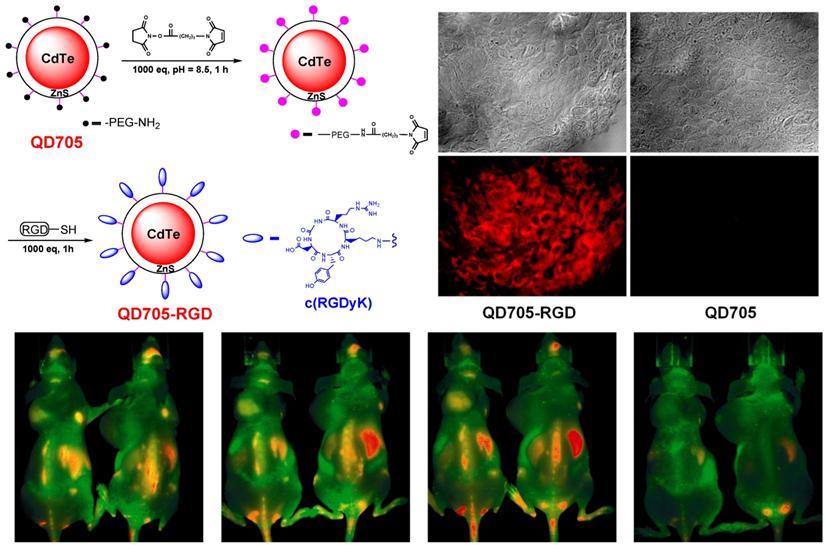
Fluorescence signal of QD705-RGD was observed in the tumor as early as 20 min after i.v. injection (200 pmol of QD705-RGD, 6-10 nmol of peptide). The tumor signal intensity reached a maximum at 6 h. The tumor/background ratios (n = 3) were 3.08 ± 1.42, 3.39 ± 1.13, 4.42 ± 1.88, and 2.09 ± 1.17 at 1, 4, 6, and 27 h after injection, respectively. No significant fluorescent signal was observed in the tumor at all time points after i.v. injection of QD705. After mice were euthanized 6 h postinjection, the U87MG tumors harvested mice showed clear signal intensity from QD705-RGD, but no signal was observed in tumors from QD705 mice. The signals from the QD705-RGD tumors were heterogeneous and were mainly from the tumor vasculature. Microscopic studies on tumor cryosections confirmed that QD705-RGD were in the tumor vasculature without tumor extravasation. This work provided the first example of RGD-bearing QDs for in vivo targeting and optical imaging of integrin positive tumor vasculature in a mouse model.
Schematic structure of integrin targeting paramagnetic quantum dots.
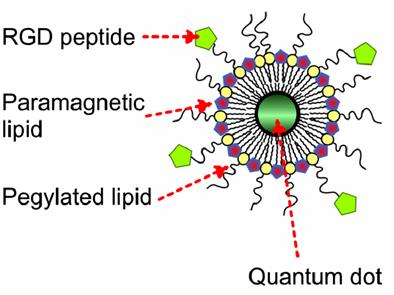
Mulder et al. reported a novel αvβ3-specific quantum dot-based nanoparticle, which has been optimized for both optical and magnetic resonance detection of tumor angiogenesis [74]. The nanoparticulate contrast agent (Fig. 16) consists of a quantum dot core covered by a micellar shell composed of pegylated phospholipid (PEG-DSPE) and Gd-DTPA-based lipids (Gd-DTPA-BSA), of which the latter have paramagnetic properties for MRI. Cyclic RGD peptide molecules were conjugated to the nanoparticles. Upon intravenous injection of RGD-pQDs in tumor-bearing mice, intravital microscopy allowed the detection of angiogenically activated endothelium at cellular resolution with a small scanning window and limited penetration depth, while magnetic resonance imaging was used to visualize angiogenesis at anatomical resolution throughout the entire tumor. Fluorescence imaging allowed whole-body investigation of angiogenic activity. Using these quantum dots and the aforementioned imaging modalities, the angiogenic tumor vasculature was readily detected with the highest angiogenic activity occurring in the periphery of the tumor.
This nanoparticle may be employed for multimodality imaging of a variety of diseases that are accompanied by activation of endothelial cells. Furthermore, the current technology might be developed for molecular imaging of other pathophysiological processes.
Integrin αvβ3-Targeted PAMAM Dendrimers Polyamidoamine (PAMAM) dendrimers have received considerable attention for their potential biomedical applications since their introduction by Tomalia and co-workers in 1985. PAMAM bearing chelated gadolinium (Gd(III)) serve as a novel class of magnetic resonance imaging (MRI) contrast agents of high molar relaxivities and superb image enhancement. Boswell et al. reported that the synthesis, characterization, and biological evaluation of robust multimodal integrin αvβ3-targeted PAMAM dendrimers with fluorescent dyes for optical imaging and chelates for gadolinium-based magnetic resonance (MR) imaging of tumor angiogenesis (Fig. 17) [75]. Fluorescence microscopy revealed selective binding of the resulting RGD peptide-bearing dendrimer with empty chelates to integrin αvβ3-expressing M21 cells, but somewhat reduced selectivity was observed following Gd(III) complexation. The expected incomplete saturation of chelates with Gd(III) ions permitted radiometal complexation, The RGD peptide-bearing gadomer was also labeled with 111In using available empty chelates, and an in vivo tissue distribution of the resulting agent in M21 melanoma tumor-bearing mice showed mostly renal and reticuloendothelial accumulation. An in vivo tissue distribution study in tumor-bearing mice showed disappointingly little tumor accumulation.
Silica nanoparticles as a platform for multimodality imaging Nanoparticles that allow combined fluorescence imaging and MRI are probably the most frequently studied because they unite the high sensitivity of the fluorescence phenomenon with the high spatial resolution of MRI. Silica nanoparticles can be used as carriers for a wide range of substances and have received considerable attention for their potential biomedical applications. Koole et al. reported a novel method for creating biocompatible and target-specific silica particles coated with a dense monolayer of paramagnetic and PEGylated lipids to improve circulation time and the biocompatibility for both MRI and fluorescence imaging (Fig. 18) [76-77]. The silica nanoparticles having a quantum dot in their center were made target-specific by the conjugation of multiple RGD peptides. A highly monodisperse, fluorescent, and paramagnetic contrast agent suitable for both fluorescence imaging and MRI studies was obtained. Their specific uptake was demonstrated by endothelial cells in vitro using fluorescence microscopy, quantitative fluorescence imaging and magnetic resonance imaging. Such lipid coated silica particles represent a new platform for nanoparticulate multimodality contrast agents.
Schematic structure of integrin αvβ3-targeted PAMAM dendrimer carrying both fluorescent dyes and Gd chelates.
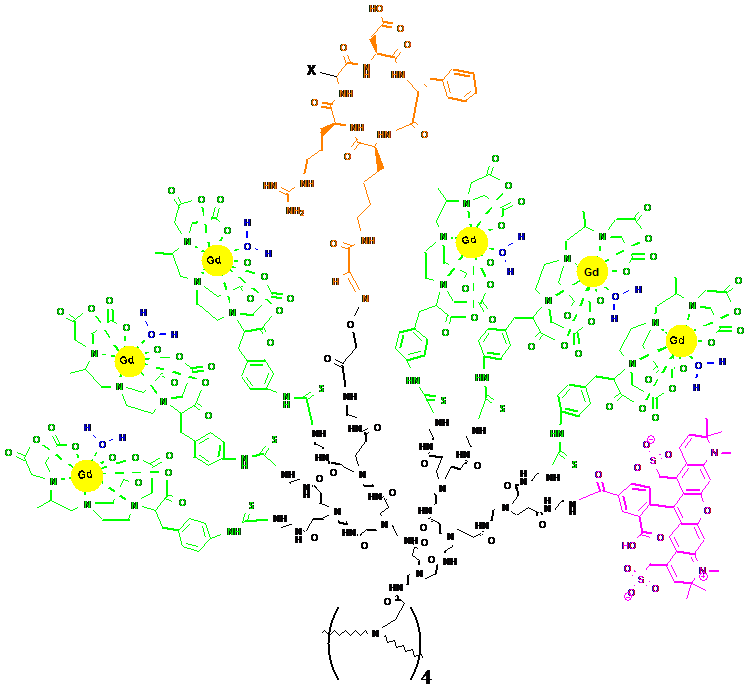
Silica nanoparticles containing QD in the core and PEGylated lipid and paramagnetic lipid coating.
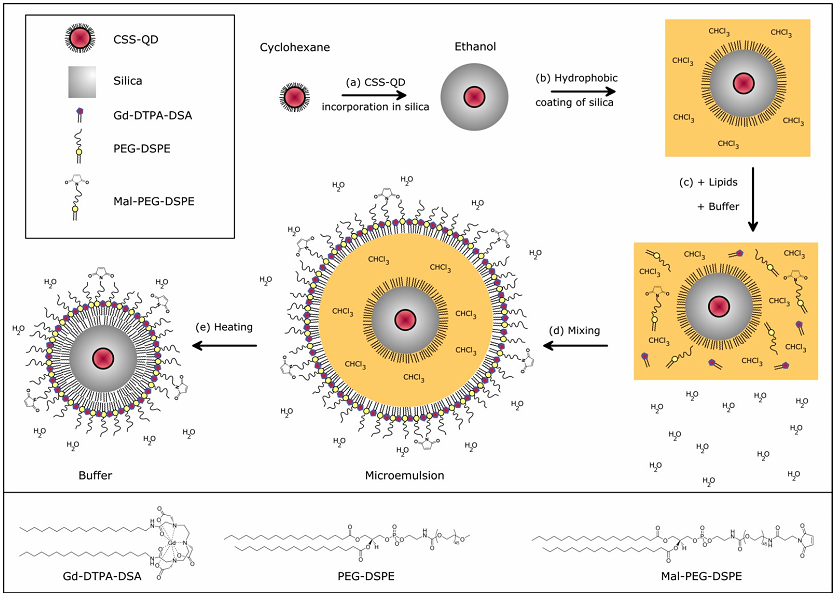
Integrin-targeted optical imaging by other methods Over the past years, some new optical imaging techniques have been developed such as fluorescence-mediated tomography, diffuse optical tomography, and two photon microscopic imaging, and fluorescence life time measurement [78,79]. They offer a range of new capabilities for molecular imaging to enhance biomedical studies. Correspondingly, they have exerted significant impacts on the construction and evaluation of new optical agents.
As described above, von Wallbrunn et al. used FMT to study a Cy5.5-labeled disulfide-based cyclic RGD peptide for optical imaging of integrin αvβ3 expression [63]. Compared to two-dimensional planar fluorescence reflectance imaging (FRI), FMT allowed quantification of the fluorochrome distribution in deeper tissue sections. FMT can provide more accurate, sensitive, specific, quantitative, three-dimensional imaging information and has great potential for clinical applications. Moreover, recent technical advances suggest that cross-sectional optical imaging techniques may be applied not only experimentally but also for patient care (e.g. optical mammography) and may therefore significantly enhance the sensitivity and specificity of diagnostic procedures. RGD-Cy5.5 combined with novel tomographic optical imaging methods allows non-invasive imaging of tumor-associated αvβ3 expression and may thus be a promising strategy for sensitive evaluation of tumor target expression.
Local molecular and physiological processes can be imaged in vivo through perturbations in the fluorescence lifetime (FLT) of optical imaging agents. In addition to providing functional information, FLT methods can quantify specific molecular events and multiplex diagnostic and prognostic information. Northdurft et al. reported a fluorescence lifetime diffuse optical tomography (DOT) system (FLT-DOT) for in vivo preclinical imaging [79]. By using differential phase measurements, they demonstrate DOT imaging of short lifetimes (from 350 ps) with high precision (+/-5 ps). Furthermore, this system retains the efficiency, speed, and flexibility of transmission geometry DOT. They used this method to successfully visualize the uptake of a near-infrared (NIR) fluorescent-labeled peptide probe i.e. cypate-RGD by a subcutaneous tumor in a mouse model.
Smith et al. used intravital microscope with subcellular (approximately 0.5 microm) resolution to further study the interactions of the RGD-conjugated QDs with tumor neovasculature in living mouse models. For the first time, the binding of such RGD-nanoparticle conjugates to tumor blood vessels in living was visualized and recorded. The nanoparticles were also found to bind in aggregation forms without extravasation [80].
Multiphoton fluorescence microscopy is a powerful tool for biological imaging and for the study of dynamic processes in living cells. This application is dependent on the development of highly fluorescent, water-soluble, photochemically stable, multiphoton absorbing chromophores. Most known fluorescent probes that can be utilized in one-photon fluorescence bioimaging are not optimized for two-photon excitation. Morales et al. reported the synthesis and identification of a new fluorene derivative, 3-(9-(2-(2-methoxyethoxy)ethyl)-2,7-bis{3-[2-(polyethyleneglycol-550-monomethylether-1-yl)]-4-(benzo[d]thiazol-2-yl)styryl}-9H-fluoren-9-yl)propanoic acid [81]. Comprehensive spectral analysis of the linear and nonlinear optical properties of this new water-soluble fluorenyl derivative, along with its high fluorescence quantum yield and photochemical stability, makes this compound an intriguing candidate for use as a fluorescence probe. Its RGD conjugate was incubated with U87MG cells (and MCF-7 as control) and exhibited high integrin αvβ3 selectivity in both conventional (one-photon) and two-photon fluorescence microscopy imaging.
Photodynamic therapy (PDT) provides an alternative approach for cancer therapy in the clinic. Tetrapyrrol chromophores, such as porphyrins, chlorins, benzochlorins, bacteriochlorin and phthalocyanines, are well-known photosensitizers. They can generate singlet oxygen and radicals from their long-lived triplet excited states to initiate cellular toxicity events. Many tetrapyrroles have red-shifted absorption and reasonable fluorescence emission (lifetime ~ 10 ns), making them applicable for diagnostic purposes. Photosensitisers generally have little intrinsic selectivity for tumors and any accumulation is dependent upon the type of tumor involved. Integrin-targeted delivery has also provided a way for increasing tumor selective accumulation of a PDT to reduce any risk of side effects caused by photosensitiser accumulation in non-target tissue and improving the therapeutic efficacy of PDT agents potentially. As reported by Conway et al. [3], protoporphyrin IX (PpIX) was conjugated with cyclic RGDfK peptide (Fig. 19). It retained their respective photodynamic and integrin binding activity. The PpIX:cRGDfK conjugate is shown to be a good photosensitiser in vitro in the integrin positive human SiHa cell line and in vivo in a mouse CaNT tumor model. Moreover, pharmacokinetic analysis of PpIX:cRGDfK treated mice showed significant retention and accumulation of photosensitizer in tumor tissue with higher tumor : normal tissue ratios than the free photosensitizer. However, the overall in vivo PDT effect, between dose-light intervals of 0 and 6 h, is not significantly better than the free protoporphyrin IX. This is possibly due to differences in the target environment or in the subcellular localisation of the compounds.
Schematic structure of PpIX:cRGDfK conjugate.

4. Conclusions and Perspectives
Integrin receptors serve as attractive targets for both molecular imaging and therapy. Some promising data from preclinical and clinical studies demonstrate the applications of their ligands as vectors for targeted delivery of anticancer agents and imaging agents [82-84]. As summarized above, various types of optical probes based on RGD-containing small molecules and fluorescent nanoparticles have been designed, synthesized and evaluated for tumor optical imaging. The high specificity and sensitivity of some integrin targeted probes for tumor optical imaging in tumor-bearing mouse models demonstrate the great potential of integrin targeting in cancer imaging and targeted therapy. All these results have further deepened our understanding of integrin receptor expression in tumor targeting and imaging. These integrin-targeted optical agents can become valuable tools for studying integrin receptors and related signaling transduction in cancer biology. It is important to further explore their potential by studying their toxicity, and pharmacokinetics as well as tumor imaging specificity and selectivity in different models for translational studies and final regulatory approvals.
The above examples illustrate the great potential of optical imaging technologies in oncologic drug discovery and development. As reported previously, integrin antagonists such as cyclic RGD peptide analogs are potential anticancer agents due to their anti-angiogenesis, apoptotic induction, and selective cytotoxicity. They can also serve as potential integrin-targeting vectors for drug delivery. Therefore, the integrin-targeted optical agents may serve as a novel type of theranostic agents for simultaneous molecular imaging and targeted therapy. The related in vivo optical imaging can provide insights into the rational design, structural optimization, and evaluation of new integrin-targeted anticancer agents.
Further work in the field will be expected to enlarge the scope of integrin-targeted optical imaging and advance both the fundamental and applied knowledge in different aspects: 1) new, innovative optical probes with improved optical properties such as quantum yield, life time, photo-stabilities, and biocompatibilities; 2) new integrin-targeting ligands including both peptides and peptidomimetics; 3) new integrin-targeted multifunctional optical probes including both small molecules and nanoparticle-based compounds for integrating optical imaging with other imaging and therapy modalities; 4) new integrin-targeting multifunctional activatable optical probes.
Imaging methods used in the clinic are not perfect to warrant complete accurate cancer detection and diagnosis. Despite the drawback of optical imaging in its limited tissue penetration, there have been some successful applications in the clinic such as cancer detection, lymphatic imaging (sentinel lymph node detection), surgical/endoscopic guidance, and optical mammography. This is because optical imaging can complement some other imaging methods to some extent. With further development of new targeted optical agents, techniques and instrumentations, optical imaging is expected to play increasingly important roles in clinical cancer imaging. Consequently, all these will lead to the improvements of cancer imaging, therapy, and even prevention.
Conflict of Interest
The authors have declared that no conflict of interest exists.
References
1. Ballou B, Ernst LA, Waggoner AS. Fluorescence imaging of tumors in vivo. Curr Med Chem. 2005;12:795-805
2. Citrin D, Camphausen K. Optical imaging of mice in oncologic research. Expert Rev Anticancer Ther. 2004;4:857-64
3. Clare L. Conway IW, Andrea Bell, David J. H. Roberts, Stanley B. Brown and David I. Vernon. In vivo and in vitro characterisation of a protoporphyrin IX-cyclic RGD peptide conjugate for use in photodynamic therapy. Photochem Photobiol Sci. 2008;7:290-8
4. Hsu AR, Chen X. Advances in anatomic, functional, and molecular imaging of angiogenesis. J Nucl Med. 2008;49:511-4
5. Kosaka N, Ogawa M, Choyke PL, Kobayashi H. Clinical implications of near-infrared fluorescence imaging in cancer. Future Oncol. 2009;5:1501-11
6. Kumar S, Richards-Kortum R. Optical molecular imaging agents for cancer diagnostics and therapeutics. Nanomedicine (Lond). 2006;1:23-30
7. Licha K, Olbrich C. Optical imaging in drug discovery and diagnostic applications. Adv Drug Deliv Rev. 2005;57:1087-108
8. Luker GD, Luker KE. Optical imaging: Current applications and future directions. J Nucl Med. 2008;49:1-4
9. McDonald DM, Choyke PL. Imaging of angiogenesis: from microscope to clinic. Nat Med. 2003;9:713-25
10. Moriyama EH, Zheng G, Wilson BC. Optical molecular imaging: from single cell to patient. Clin Pharmacol Ther. 2008;84:267-71
11. Bremer C, Ntziachristos V, Weissleder R. Optical-based molecular imaging: contrast agents and potential medical applications. Eur Radiol. 2003;13:231-43
12. Rao J, Dragulescu-Andrasi A, Yao H. Fluorescence imaging in vivo: recent advances. Curr Opin Biotechnol. 2007;18:17-25
13. Shah K, Weissleder R. Molecular optical imaging: applications leading to the development of present day therapeutics. NeuroRx. 2005;2:215-25
14. Wessels JT, Busse AC, Mahrt J, Dullin C, Grabbe E, Mueller GA. In vivo imaging in experimental preclinical tumor research--a review. Cytometry A. 2007;71:542-9
15. Contag CH, Ross BD. It's not just about anatomy: In vivo bioluminescence imaging as an eyepiece into biology. J Magn Reson Imaging. 2002;16:378-87
16. Tung CH. Fluorescent peptide probes for in vivo diagnostic imaging. Biopolymers. 2004;76:391-403
17. Gao X, Cui Y, Levenson RM, Chung LW, Nie S. In vivo cancer targeting and imaging with semiconductor quantum dots. Nat Biotechnol. 2004;22:969-76
18. Soto CM, Blum AS, Vora GJ, Lebedev N, Meador CE, Won AP. et al. Fluorescent signal amplification of carbocyanine dyes using engineered viral nanoparticles. J Am Chem Soc. 2006;128:5184-9
19. Tsien RY. The 2009 Lindau Nobel Laureate Meeting: Roger Y. Tsien, Chemistry 2008. J Vis Exp. 2010(35 pii):1575
20. Tsien RY. The green fluorescent protein. Annu Rev Biochem. 1998;67:509-44
21. Haglund MM, Hochman DW, Spence AM, Berger MS. Enhanced Optical Imaging of Rat Gliomas and Tumor Margins. Neurosurgery. 1994;35:930-40
22. Ntziachristos V, Yodh AG, Schnall M, Chance B. Concurrent MRI and diffuse optical tomography of breast after indocyanine green enhancement. P Natl Acad Sci USA. 2000;97:2767-72
23. Reynolds JS, Troy TL, Mayer RH, Thompson AB, Waters DJ, Cornell KK. et al. Imaging of spontaneous canine mammary tumors using fluorescent contrast agents. Photochem Photobiol. 1999;70:87-94
24. Brancato R, Trabucchi G. Fluorescein and indocyanine green angiography in vascular chorioretinal diseases. Semin Ophthalmol. 1998;13:189-98
25. Flower RW, Hochheimer BF. Indocyanine green dye fluorescence and infrared absorption choroidal angiography performed simultaneously with fluorescein angiography. Johns Hopkins Med J. 1976;138:33-42
26. Gao X, Dave SR. Quantum dots for cancer molecular imaging. Adv Exp Med Biol. 2007;620:57-73
27. Leamon CP, Low PS. Folate-mediated targeting: from diagnostics to drug and gene delivery. Drug Discov Today. 2001;6:44-51
28. Leamon CP, Low PS. Receptor-mediated drug delivery. In: (ed.) Wang B. et al. Drug Delivery: Principles and applications. US: John Wiley & Sons. 2005:167-87
29. Jaracz S, Chen J, Kuznetsova LV, Ojima L. Recent advances in tumor-targeting anticancer drug conjugates. Bioorgan Med Chem. 2005;13:5043-54
30. Mezo G, Manea M. Receptor-mediated tumor targeting based on peptide hormones. Expert Opin Drug Del. 2010;7:79-96
31. De S, Razorenova O, McCabe NP, O'Toole T, Qin J, Byzova TV. VEGF-integrin interplay controls tumor growth and vascularization. P Natl Acad Sci USA. 2005;102:7589-94
32. Playford MP, Schaller MD. The interplay between Src and integrins in normal and tumor biology. Oncogene. 2004;23:7928-46
33. Engl T, Relja B, Marian D, Blumenberg C, Muller I, Beecken WD. et al. CXCR4 chemokine receptor mediates prostate tumor cell adhesion through α5 and β3 integrins. Neoplasia. 2006;8:290-301
34. Lorger M, Krueger JS, O'Neal M, Staflin K, Felding-Habermann B. Activation of tumor cell integrin αvβ3 controls angiogenesis and metastatic growth in the brain. Proc Natl Acad Sci U S A. 2009;106:10666-71
35. Schottelius M, Laufer B, Kessler H, Wester HJ. Ligands for mapping αvβ3-integrin expression in vivo. Acc Chem Res. 2009;42:969-80
36. Beer AJ, Schwaiger M. Imaging of integrin αvβ3 expression. Cancer Metastasis Rev. 2008;27:631-44
37. Haubner R, Weber WA, Beer AJ, Vabuliene E, Reim D, Sarbia M. et al. Noninvasive visualization of the activated alphavbeta3 integrin in cancer patients by positron emission tomography and [18F]Galacto-RGD. PLoS Med. 2005;2:e70
38. Harris TD, Cheesman E, Harris AR, Sachleben R, Edwards DS, Liu S. et al. Radiolabeled divalent peptidomimetic vitronectin receptor antagonists as potential tumor radiotherapeutic and imaging agents. Bioconjugate Chem. 2007;18:1266-79
39. Jin ZH, Furukawa T, Waki A, Akaji K, Coll JL, Saga T. et al. Effect of Multimerization of a Linear Arg-Gly-Asp Peptide on Integrin Binding Affinity and Specificity. Biol Pharm Bull. 2010;33:370-8
40. Ye YP, Bloch S, Xu BG, Achilefu S. Design, synthesis, and evaluation of near infrared fluorescent multimeric RGD peptides for targeting tumors. J Med Chem. 2006;49:2268-75
41. Achilefu S, Bloch S, Markiewicz MA, Zhong T, Ye Y, Dorshow RB. et al. Synergistic effects of light-emitting probes and peptides for targeting and monitoring integrin expression. Proc Natl Acad Sci U S A. 2005;102:7976-81
42. Liu Z, Liu S, Niu G, Wang F, Liu S, Chen X. Optical imaging of integrin alphavbeta3 expression with near-infrared fluorescent RGD dimer with tetra(ethylene glycol) linkers. Mol Imaging. 2010;9:21-9
43. Ye Y, Li WP, Anderson CJ, Kao J, Nikiforovich GV, Achilefu S. Synthesis and characterization of a macrocyclic near-infrared optical scaffold. J Am Chem Soc. 2003;125:7766-7
44. Lin Y, Weissleder R, Tung CH. Synthesis and properties of sulfhydryl-reactive near-infrared cyanine fluorochromes for fluorescence imaging. Mol Imaging. 2003;2:87-92
45. Cheng Z, Wu Y, Xiong Z, Gambhir SS, Chen X. Near-infrared fluorescent RGD peptides for optical imaging of integrin αvβ3 expression in living mice. Bioconjug Chem. 2005;16:1433-41
46. Chen X, Conti PS, Moats RA. In vivo near-infrared fluorescence imaging of integrin alphavbeta3 in brain tumor xenografts. Cancer Res. 2004;64:8009-14
47. Wang W, Ke S, Wu Q, Charnsangavej C, Gurfinkel M, Gelovani JG. et al. Near-infrared optical imaging of integrin αvβ3 in human tumor xenografts. Mol Imaging. 2004;3:343-51
48. Gurfinkel M, Ke S, Wang W, Li C, Sevick-Muraca EM. Quantifying molecular specificity of αvβ3 integrin-targeted optical contrast agents with dynamic optical imaging. J Biomed Opt. 2005;10:034019
49. Jin ZH, Josserand V, Razkin J, Garanger E, Boturyn D, Favrot MC, Dumy P, Coll JL. Noninvasive optical imaging of ovarian metastases using Cy5-labeled RAFT-c(-RGDfK-)4. Mol Imaging. 2006;5:188-97
50. Garanger E, Boturyn D, Coll JL, Favrot MC, Dumy P. Multivalent RGD synthetic peptides as potent αvβ3 integrin ligands. Org Biomol Chem. 2006;4:1958-65
51. Li C, Wang W, Wu Q, Ke S, Houston J, Sevick-Muraca E. et al. Dual optical and nuclear imaging in human melanoma xenografts using a single targeted imaging probe. Nucl Med Biol. 2006;33:349-58
52. Lee H, Akers WJ, Cheney PP, Edwards WB, Liang K, Culver JP. et al. Complementary optical and nuclear imaging of caspase-3 activity using combined activatable and radio-labeled multimodality molecular probe. J Biomed Opt. 2009;14:040507
53. Cai W, Chen K, Li ZB, Gambhir SS, Chen X. Dual-function probe for PET and near-infrared fluorescence imaging of tumor vasculature. J Nucl Med. 2007;48:1862-70
54. Edwards WB, Akers WJ, Ye Y, Cheney PP, Bloch S, Xu B. et al. Multimodal imaging of integrin receptor-positive tumors by bioluminescence, fluorescence, gamma scintigraphy, and single-photon emission computed tomography using a cyclic RGD peptide labeled with a near-infrared fluorescent dye and a radionuclide. Mol Imaging. 2009;8:101-10
55. Tung CH, Bredow S, Mahmood U, Weissleder R. Preparation of a cathepsin D sensitive near-infrared fluorescence probe for imaging. Bioconjug Chem. 1999;10:892-6
56. Tung CH, Mahmood U, Bredow S, Weissleder R. In vivo imaging of proteolytic enzyme activity using a novel molecular reporter. Cancer Res. 2000;60:4953-8
57. Bremer C, Bredow S, Mahmood U, Weissleder R, Tung CH. Optical imaging of matrix metalloproteinase-2 activity in tumors: feasibility study in a mouse model. Radiology. 2001;221:523-9
58. Lee S, Park K, Kim K, Choi K, Kwon IC. Activatable imaging probes with amplified fluorescent signals. Chem Commun (Camb). 2008(36):4250-60
59. Nguyen QT, Olson ES, Aguilera TA, Jiang T, Scadeng M, Ellies LG. et al. Surgery with molecular fluorescence imaging using activatable cell-penetrating peptides decreases residual cancer and improves survival. Proc Natl Acad Sci U S A. 2010;107:4317-22
60. Razkin J, Josserand V, Boturyn D, Jin ZH, Dumy P, Favrot M. et al. Activatable fluorescent probes for tumour-targeting imaging in live mice. ChemMedChem. 2006;1:1069-72
61. Carlson CB, Mowery P, Owen RM, Dykhuizen EC, Kiessling LL. Selective tumor cell targeting using low-affinity, multivalent interactions. ACS Chem Biol. 2007;2:119-27
62. Bloch S, Xu B, Ye Y, Liang K, Nikiforovich GV, Achilefu S. Targeting β3 integrin using a linear hexapeptide labeled with a near-infrared fluorescent molecular probe. Mol Pharm. 2006;3:539-49
63. von Wallbrunn A, Höltke C, Zühlsdorf M, Heindel W, Schäfers M, Bremer C. In vivo imaging of integrin αvβ3 expression using fluorescence-mediated tomography. Eur J Nucl Med Mol Imaging. 2007;34:745-54
64. Sugahara KN, Teesalu T, Karmali PP, Kotamraju VR, Agemy L, Girard OM. et al. Tissue-penetrating delivery of compounds and nanoparticles into tumors. Cancer Cell. 2009;16:510-20
65. Heroux J, Gharib AM, Danthi NS, Cecchini S, Ohayon J, Pettigrew RI. High-affinity αvβ3 integrin targeted optical probe as a new imaging biomarker for early atherosclerosis: initial studies in Watanabe rabbits. Mol Imaging Biol. 2010;12:2-8
66. Peng L, Liu R, Andrei M, Xiao W, Lam KS. In vivo optical imaging of human lymphoma xenograft using a library-derived peptidomimetic against α4β1 integrin. Mol Cancer Ther. 2008;7:432-7
67. Aina OH, Marik J, Gandour-Edwards R, Lam KS. Near-infrared optical imaging of ovarian cancer xenografts with novel α3-integrin binding peptide "OA02". Mol Imaging. 2005;4:439-47
68. Xiao W, Yao N, Peng L, Liu R, Lam KS. Near-infrared optical imaging in glioblastoma xenograft with ligand-targeting α3 integrin. Eur J Nucl Med Mol Imaging. 2009;36:94-103
69. Yao N, Xiao W, Wang X, Marik J, Park SH, Takada Y. et al. Discovery of targeting ligands for breast cancer cells using the one-bead one-compound combinatorial method. J Med Chem. 2009;52:126-33
70. Cai W, Chen X. Preparation of peptide-conjugated quantum dots for tumor vasculature-targeted imaging. Nat Protoc. 2008;3:89-96
71. Akers W, Lesage F, Holten D, Achilefu S. In vivo resolution of multiexponential decays of multiple near-infrared molecular probes by fluorescence lifetime-gated whole-body time-resolved diffuse optical imaging. Mol Imaging. 2007;6:237-46
72. Cai W, Chen X. Anti-angiogenic cancer therapy based on integrin αvβ3 antagonism. Anticancer Agents Med Chem. 2006;6:407-28
73. Cai W, Shin DW, Chen K, Gheysens O, Cao Q, Wang SX. et al. Peptide-labeled near-infrared quantum dots for imaging tumor vasculature in living subjects. Nano Lett. 2006;6:669-76
74. Mulder WJ, Castermans K, van Beijnum JR, Oude Egbrink MG, Chin PT, Fayad ZA. et al. Molecular imaging of tumor angiogenesis using αvβ3-integrin targeted multimodal quantum dots. Angiogenesis. 2009;12:17-24
75. Boswell CA, Eck PK, Regino CA, Bernardo M, Wong KJ, Milenic DE. et al. Synthesis, characterization, and biological evaluation of integrin αvβ3-targeted PAMAM dendrimers. Mol Pharm. 2008;5:527-39
76. Koole R, van Schooneveld MM, Hilhorst J, Castermans K, Cormode DP, Strijkers GJ. et al. Paramagnetic lipid-coated silica nanoparticles with a fluorescent quantum dot core: a new contrast agent platform for multimodality imaging. Bioconjug Chem. 2008;19:2471-9
77. van Schooneveld MM, Vucic E, Koole R, Zhou Y, Stocks J, Cormode DP. et al. Improved biocompatibility and pharmacokinetics of silica nanoparticles by means of a lipid coating: a multimodality investigation. Nano Lett. 2008;8:2517-25
78. Montet X, Ntziachristos V, Grimm J, Weissleder R. Tomographic fluorescence mapping of tumor targets. Cancer Res. 2005;65:6330-6
79. Nothdurft RE, Patwardhan SV, Akers W, Ye Y, Achilefu S, Culver JP. In vivo fluorescence lifetime tomography. J Biomed Opt. 2009;14:024004
80. Smith BR, Cheng Z, De A, Koh AL, Sinclair R, Gambhir SS. Real-time intravital imaging of RGD-quantum dot binding to luminal endothelium in mouse tumor neovasculature. Nano Lett. 2008;8:2599-606
81. Morales AR, Luchita G, Yanez CO, Bondar MV, Przhonska OV, Belfield KD. Linear and nonlinear photophysics and bioimaging of an integrin-targeting water-soluble fluorenyl probe. Org Biomol Chem. 2010;8(11):2600-8
82. Arap W, Pasqualini R, Ruoslahti E. Cancer treatment by targeted drug delivery to tumor vasculature in a mouse model. Science. 1998;279:377-80
83. Cao Q, Li ZB, Chen K, Wu Z, He L, Neamati N. et al. Evaluation of biodistribution and anti-tumor effect of a dimeric RGD peptide-paclitaxel conjugate in mice with breast cancer. Eur J Nucl Med Mol Imaging. 2008;35:1489-98
84. Chen CC, Lee KD, Gau JP, Yu YB, You JY, Lee SC. et al. Plasma antigen levels of thrombin-activatable fibrinolysis inhibitor did not differ in patients with or without disseminated intravascular coagulation. Ann Hematol. 2005;84:675-80
Author contact
![]() Corresponding author: Dr. Xiaoyuan Chen, Laboratory of Molecular Imaging and Nanomedicine (LOMIN), National Institute of Biomedical Imaging and Bioengineering (NIBIB), National Institute of Health (NIH), 31 Center Dr, 31/1C22, Bethesda, MD 20892, USA; Tel: 301-451-4246; Email: shawn.chengov
Corresponding author: Dr. Xiaoyuan Chen, Laboratory of Molecular Imaging and Nanomedicine (LOMIN), National Institute of Biomedical Imaging and Bioengineering (NIBIB), National Institute of Health (NIH), 31 Center Dr, 31/1C22, Bethesda, MD 20892, USA; Tel: 301-451-4246; Email: shawn.chengov
 Global reach, higher impact
Global reach, higher impact